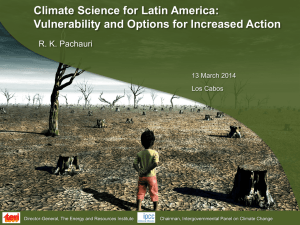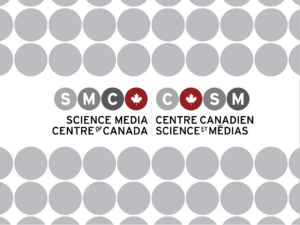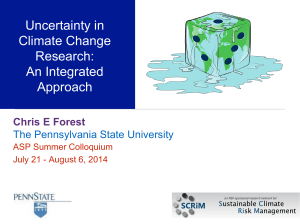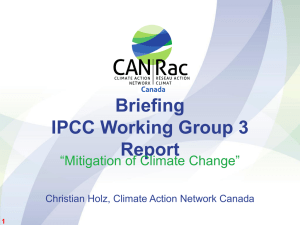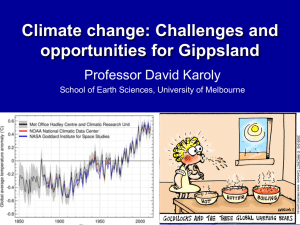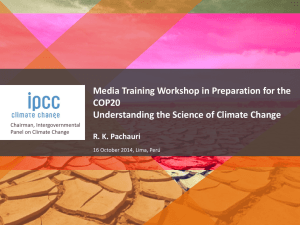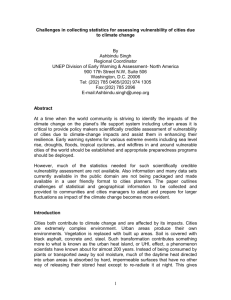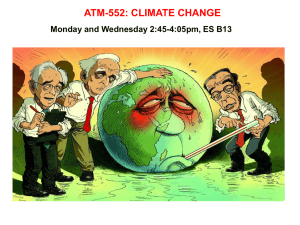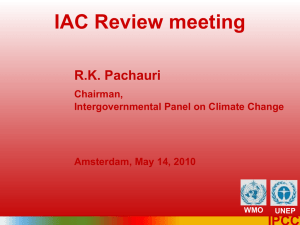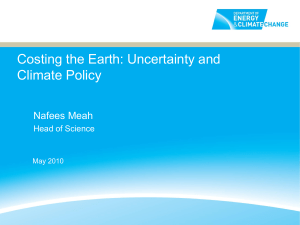the presentation by Dr. R K Pachauri
advertisement
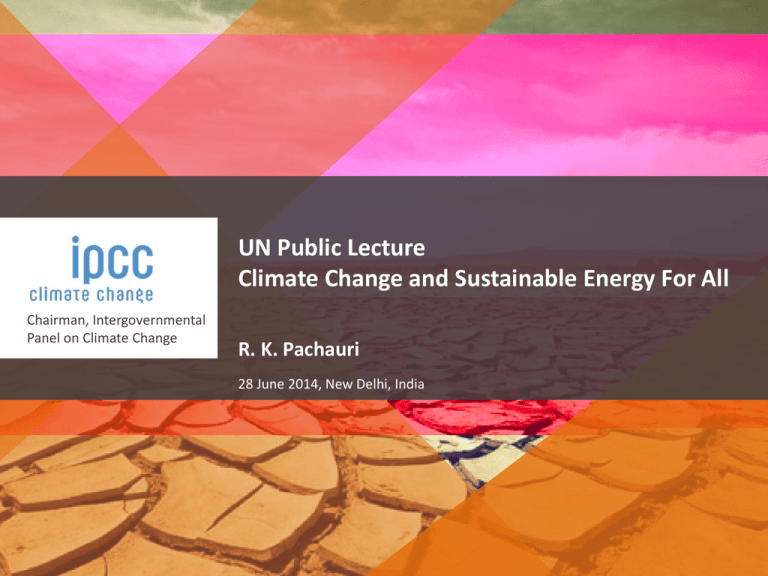
UN Public Lecture Climate Change and Sustainable Energy For All Chairman, Intergovernmental Panel on Climate Change R. K. Pachauri 28 June 2014, New Delhi, India “Sustainable development is development that meets the needs of the present without compromising the ability of future generations to meet their own needs.” Sustainable Energy For All - Background Energy enables. Energy lies at the heart of all countries’ core interests, including: • job creation • economic development • security concerns • full empowerment of women In September 2011, UN Secretary General launched the SE4ALL initiative. All spheres of society (business, government, civil society, community groups, academia etc.) to make sustainable energy for all a reality by 2030 by working in partnership. Source : ttp://www.se4all.org/ 3 Sustainable Energy for All – the challenges “Energy is the golden thread that connects economic growth, increased social equity, and an environment that allows the world to thrive” ~ UNSG Ban Ki Moon Energy access • Nearly 1 in 5 on the planet lacks access to electricity • Almost 3 billion people rely on wood, coal, charcoal or animal waste for cooking and heating • This is a major barrier to eradicating poverty and building shared prosperity Source : ttp://www.se4all.org/ Climate change • Where modern energy services are plentiful, the problem is: waste and pollution • Anthropogenic emissions are contributing to climate change • This has impacts on lives, communities, infrastructure, institutions and budgets • Climate change impacts the poor first and worst 4 Sustainable Energy for All Achieving the three objectives together will maximize development benefits and help stabilize climate change over the long run. The objectives are complementary. The key to both challenges is to provide sustainable energy for all. SE4ALL is focused on attaining 3 objectives: • Ensure universal access to modern energy services • Double the share of renewable energy in the global energy mix • Double the global rate of improvement in energy efficiency Source : ttp://www.se4all.org/ 5 Sustainable Energy For All To make the vision of Sustainable Energy for All actionable, the three core objectives have been disaggregated into 11 Action Areas The 11 Action Areas address almost 95% of global energy consumption, key components of productive energy use, and the supporting mechanisms needed. Source : SE4ALL, A Global Action Agenda 6 Sustainable Energy for All Opportunities Sustainable energy creates new opportunities: • Enables businesses to grow • Generates jobs • Creates new markets • Children can study after dark • Clinics can store life-saving vaccines • Countries can grow more resilient, competitive economies. 7 IPCC Fifth Assessment Report A MORE VIBRANT WORLD Greenhouse gases Limiting climate change will require sustained and substantial reductions in greenhouse gas emissions • Total anthropogenic GHG emissions have continued to increase over 1970 to 2010 (highest in human history from 2000 to 2010) • CO2 emissions from fossil fuel combustion and industrial processes contributed about 78 % of the total GHG emission increase from 1970 to 2010 • About half of cumulative anthropogenic CO2 emissions between 1750 and 2010 have occurred in the last 40 years • In baseline scenarios, direct CO2 emissions from the energy supply sector are projected to double or triple by 2050 compared to 2010, unless energy intensity improvements can be significantly accelerated. Source : IPCC AR5 9 Working Group I: The Physical Science Basis Human influence of the climate system is clear • 95% certainty that human influence has been the dominant cause of the observed warming since the mid-20th century • Since the 1950s, many of the observed changes are unprecedented over decades to millennia. • Human influence has been detected in warming of the atmosphere and the ocean, in changes in the global water cycle, in reductions in snow and ice, in global mean sea level rise, and in changes in some climate extremes Source : IPCC AR5 10 Observed changes in the climate system Climate change is unequivocal • The oceans have warmed and risen • The amounts of snow and ice have diminished • Sea level has risen • The concentrations of greenhouse gases have increased Source : IPCC AR5 11 Warming of the climate system is unequivocal The concentrations of greenhouse gases have increased • The atmospheric concentrations of CO2, methane, and nitrous oxide have increased to levels unprecedented in at least the past 800,000 years. • The ocean has absorbed ~30% of the emitted anthropogenic carbon dioxide, causing ocean acidification. Source : IPCC AR5 12 Trends in GHGs and their drivers Total anthropogenic GHG emissions were the highest in human history from 2000 to 2010 Greenhouse gas emissions by economic sectors • Globally, economic and population growth continue to be the most important drivers of increases in CO2 emissions from fossil fuel combustions • These are expected to continue to drive emissions growth without additional efforts to reduce GHG emissions. Source : IPCC AR5 13 Extreme events during and by the end of the 21st Century • It is very likely that the length, frequency, and/or intensity of warm spells or heat waves will increase over most land areas • Under some scenarios, a 1-in-20 year hottest day is likely to become a 1-in-2 year event in most regions • It is likely that the frequency of heavy precipitation or the proportion of total rainfall from heavy falls will increase over many areas of the globe Source : IPCC SREX Future risks of climate change in Asia • Water scarcity is expected to be a major challenge due to increased water demand and lack of good management • Higher temperatures can lead to lower rice yields. A number of regions are already near the heat stress limits for rice. • Sea level rise will inundate low lying areas and especially affect rice growing regions. • Coastal and marine systems are under increasing stress from climatic and nonclimatic drivers • Damage to coral reefs will increase during the 21st century as a result of ocean warming and acidification. Source : IPCC AR5 15 Future risks of climate change in Asia • Adverse effects on the sustainable development capabilities of most Asian developing countries by aggravating pressures on natural resources and the environment. • Increasing impact of extreme events on human health, security, livelihoods, and poverty, with the type and magnitude of impact varying across Asia. Source : IPCC AR5 16 Abrupt and irreversible impacts Most aspects of climate change will persist for many centuries even if emissions of CO2 are stopped. • Sustained mass loss by ice sheets (some of which irreversible) would cause larger sea level rise. • Sustained warming greater than some threshold (greater than about 1°C but less than about 4°C global mean warming with respect to preindustrial) would lead to the nearcomplete loss of the Greenland ice sheet over a millennium or more, causing a global mean sea level rise of up to 7 m. Source : IPCC AR5 17 Implications for sustainable development Limits to resilience are faced when thresholds or tipping points associated with social and/or natural systems are exceeded, posing severe challenges for adaptation. The interactions among climate change mitigation, adaptation, and disaster risk management may have a major influence on resilient and sustainable pathways. Interactions between the goals of mitigation and adaptation will play out locally, but have global consequences. Source : IPCC SREX 18 Adaptation and Mitigation IPCC Fifth Assessment Report “Climate-resilient pathways combine adaptation and mitigation to reduce climate change and its impacts. Since mitigation reduces the rate and magnitude of warming, it also increases the time available for adaptation to a particular level of climate change, potentially by several decades.” Source : IPCC AR5 19 EFFECTIVE CLIMATE CHANGE ADAPTATION A MORE VIBRANT WORLD There are strategies that can help manage disaster risk now and also help improve people’s livelihoods and well-being The most effective strategies offer development benefits in the relatively near term and reduce vulnerability over the longer term Source : IPCC SREX 21 Effective risk management and adaptation are tailored to local and regional needs and circumstances • Changes in climate extremes vary across regions • Each region has unique vulnerabilities and exposure to hazards • Effective risk management and adaptation address the factors contributing to exposure and vulnerability Source : IPCC SREX 22 EFFECTIVE CLIMATE CHANGE MITIGATION A MORE VIBRANT WORLD Impacts of mitigation on GDP growth Delaying additional mitigation further increases mitigation costs in the medium to long term GDP GDP without mitigation GDP with stringent mitigation (reaching ≈ 450 ppm CO2eq in 2100) Current Source : IPCC AR5 Loss in global consumption in 2030: 1.7% (median) 2030 Loss in global consumption in 2050: 3.4% (median) 2050 Loss in global consumption in 2100: 4.8% (median) 2100 Time 24 Stringent mitigation scenarios Characteristics of scenarios reaching levels of about 450 ppm CO2eq by 2100 (likely chance to keep temperature change below 2C relative to preindustrial levels): • Lower global GHGs in 2050 than in 2010 (40% to 70% lower globally) • Emissions levels near zero GtCO2eq or below in 2100 • More rapid improvements in energy efficiency • A tripling to nearly a quadrupling of the share of zero- and lowcarbon energy supply from renewables by 2050 • Nuclear energy, biomass and fossil energy with CCS, and BECCS by the year 2050 Source : IPCC AR5 25 CDR technologies Many scenarios reaching 450, 500 and 550 ppm CO2eq by 2100 Require availability and widespread deployment of BECCS and afforestation post 2050 But the availability and scale of these and other CDR technologies are uncertain and associated with challenges and risks. Source : IPCC AR5 26 Mitigation opportunities in the energy supply sector • Decarbonization of electricity generation • Renewable energy technologies • Nuclear energy could make an increasing contribution to low-carbon energy supply, but a variety of barriers and risks exist • Replacement of world average coal-fired power plants with modern natural gas combined-cycle power plants • CCS and BECCS, but entail challenges and risks Source : IPCC AR5 27 Mitigation opportunities in the energy end-use sectors Industry Transport Buildings • Wide-scale upgrading and innovation • Replacement and deployment of best available technologies • Information programmes to promote energy efficiency • Efficiency in material use, recycling and waste reduction • Collaborative approaches across companies and sectors • Technical and behavioral mitigation measures (energy efficiency and vehicle performance improvements) • Adoption of very low building codes for new buildings Source : IPCC AR5 • Infrastructure and urban redevelopment investments (more compact urban form that supports cycling and walking, high-speed rail systems) • Retrofits for existing buildings • Lifestyle, culture and behavior influence energy consumption in buildings 28 RE costs are still higher than existing energy prices but in various settings RE is already competitive. Source : IPCC SRREN 29 Co-benefits and adverse side effects There is an increased focus on policies designed to integrate multiple objectives, increase co-benefits and reduce adverse side-effects. The intersections of mitigation and adaptation with other societal goals, if well managed, can strengthen the basis for undertaking climate action: • Improved energy efficiency and security • Cleaner energy sources • Air quality and human health • Reduced energy and water consumption in urban areas • Sustainable agriculture and forestry • Protection of ecosystems for carbon storage Source : IPCC AR5 30 Climate change and sustainable development Governing a transition toward an effective climate response and SD pathway is a challenge involving rethinking our relation to nature. • A stable climate is one component of SD. • Limiting the effects of climate change is necessary to achieve SD and equity, including poverty eradication. • Designing an effective climate policy involves “mainstreaming” climate in the design of SD strategies. • Options for equitable burdensharing can reduce the potential for the costs of climate action to constrain development. Source : IPCC AR5 31 LaBL Source : IPCC LIGHTING A BILLION LIVES We commit to enable a billion lives to access light from solar technologies 1.3 billion people lack access to electricity 360 million live in India 2.2 billion litres of kerosene burnt each year for lighting About 5.5 tonnes CO2 emitted to the atmosphere by burning kerosene for this Source : TERI Lighting a Billion Lives Gobindarampur: a village benefiting from the campaign Bani and her friends run and maintain the charging station Solar lanterns have helped families in their daily activities Source : TERI Solar lanterns are used in livelihood activities such as betel leaf cultivation, coaching centres, and shops 34 “A technological society has two choices. First it can wait until catastrophic failures expose systemic deficiencies, distortion and self-deceptions… Secondly, a culture can provide social checks and balances to correct for systemic distortion prior to catastrophic failures.” - Mahatma Gandhi “Speed is irrelevant if you are going in the wrong direction” - Mahatma Gandhi
